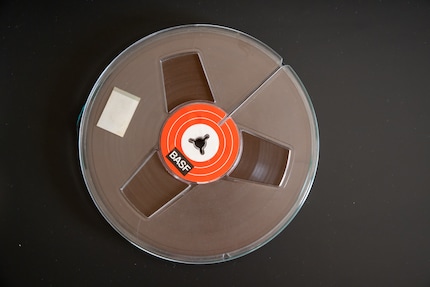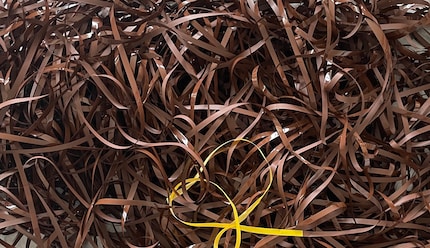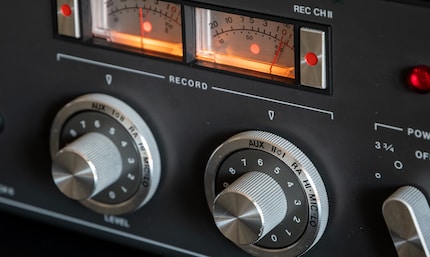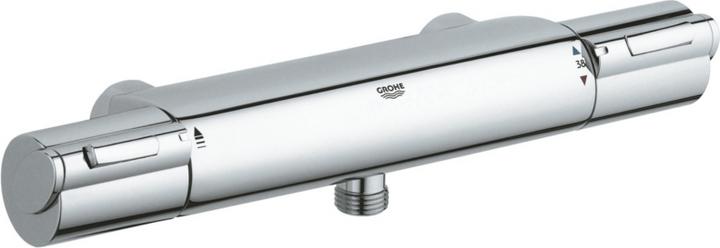
Background information
«I’ll fix it someday. I swear I will.»
by Michael Restin

Reel-to-reel tapes are for people who find cassettes too modern and records too mainstream. And for people like me, who want to relive childhood memories. A device like this is far from low-maintance. But in spite of all its irks and quirks, it still brings a great deal of joy.
I got my late father’s Revox A77 Mk IV reel-to-reel tape recorder restored. It turns out it’s from the 70s – a time when cassettes weren’t so common. This open-reel tape recorder is almost half a century old and was made in Switzerland in Germany rather than China or Japan. By a Swiss company.
The restoration work came in at a four-figure price tag, as it involved manual labour at Swiss wage prices. I ended up driving to the specialists three times because of a mixture of real and suspected faults. That meant carting the 15 kg device in my bag each time and strapping it into the backseat of the car.
But there was something else that was even more difficult to manage. And that was the fact I didn’t have a proper place to put the reel-to-reel tape recorder. So, I ordered an 80 kg sideboard. As I’d have had to wait months for a delivery to my flat, I settled with having it tipped out at the building door. The thing arrived fully assembled, which meant I had to invite a few friends round to eat first and then ask for their help manoeuvring it.
All in all, it was a fair expenditure – in more ways than one. So why bother?
I have nice memories from my childhood, and I want to rekindle them with the help of the reel-to-reel tape recorder. The fact there are much easier and more practical ways to listen to music at a higher quality doesn’t even come into it. The same goes for the money side of things. Childhood memories are priceless.
First off, music is a part of memories themselves. Reel-to-reel tapes feature music that shaped me forever, including the likes of the Beatles’ Abbey Road, Before the Flood by Bob Dylan or Simon & Garfunkel’s Bridge Over Troubled Water. I later bought these albums as CDs.
When I press «Play» or hit «Stop» later on, it’s met with a resolute «tap» – akin to a typewriter when the character hits the ribbon. This is caused by the tape heads jumping up or down. Fast-forwarding or rewinding creates a wind-like noise similar to a fan.
I want to relive my childhood memories. But after the reel-to-reel tape recorder is renovated, it becomes clear that’s not so easy. The old tapes have had it. Over the decades, they’ve corroded to the extent that when you play them back, you get abrasion. This fouls the tape heads; the sound becomes very muffled and, in some cases, the tape sticks. Not to mention cleaning the tape heads afterwards is tedious.
When I hear the result, what strikes me is that it’s not the same. And it’ll never be exactly as it was. You can’t bring back the past. The more I try to reconstruct everything so precisely, the more painfully aware I become of that fact.
So, I abandon my plans to use the Revox A77 as a time machine. Instead, it needs to find its place in the present. An heirloom shouldn’t be used to mourn the past, rather to enrich the present. I wrap high-quality metal reels around the tape and record my favourite music onto it.
As it is, the Revox A77 Mk IV is cool enough to be more than just a relic. It looks good and, under the best conditions, it sounds good too.
On the subject of sound quality, it depends on various factors. The most important part is keeping the tape heads absolutely clean. The metal parts that come into contact with the tape should also be demagnetised from time to time. I got myself a special tool with that in mind.
You know you’re a nerd when you have a tape head demagnetiser.
Personally, I wouldn’t dream of recording in mono, but that’s something my dad did a lot. Stereo didn’t become the obvious standard until the 70s. For instance, 1967’s Highway Chile by Jimi Hendrix was only released in mono.
If you’re interested in finding out more, this tech guide explains it at length and in an easy-to-follow way.
As I’ve already mentioned, the device sounds good when used under the best conditions. But the quality can easily plummet. It only takes something like a stubborn bit of dirt on the tape heads that slips under the radar, the incorrect cleaning routine or tape that doesn’t work as well. Or a whole host of other things. Compared with other tape machines, the Revox A77 is admittedly very reliable, but it’s still a fickle diva.
When I start Googling possible errors, I quickly lose myself in a world of superficial knowledge and pseudo expertise. Talk is of tape head azimuth and using a calibration tape for measurements. Do I really want to go into that much detail?
An inner voice keeps reminding me to be sensible, telling me: give it a rest, it’s a Herculean task. But there’s no denying I love this device. The more I invest in it, the more I take it to heart. Until it becomes a kind of love-hate relationship.
It seems like the tape machine produces a warm, «analogue» sound. I also record extracts from the 70s onto the tapes and notice that these already have a warm sound anyway. Even this music was first recorded onto tape before it became records. Maybe that has something to do with it.
As an amateur guitar player, I appreciate the fact the Revox A77 makes overdubbing possible. Only in mono, but still. This means I can record a bass line then layer a guitar track over it and, in a third recoding phase, add a vocal layer to it. These days, that’s not going to blow you away as, after all, it’s something you can do with an iPhone. But the thing is, standard cassette recorders still couldn’t do that decades down the line.
While I was recording, the tape counter broke, meaning I had no idea how far I had to rewind the tape. The diva strikes again.
My interest in IT and writing landed me in tech journalism early on (2000). I want to know how we can use technology without being used. Outside of the office, I’m a keen musician who makes up for lacking talent with excessive enthusiasm.
Interesting facts about products, behind-the-scenes looks at manufacturers and deep-dives on interesting people.
Show allNostalgia is a sentimental yearning for the past or practices in the past. You can feel nostalgic for your own life as well as for periods you haven’t experienced yourself (known as collective nostalgia). The word nostalgia derives from the Latin nostalgia, which in turn leads back to the Greek compound consisting of νόστος (nóstos), meaning

But it’s more than just that. When I play music on the reel-to-reel tape recorder, I don’t just hear music; I also see it. The reels move and their speed changes over time. To begin with, the right reel turns much quicker than the left, owing to its smaller circumference. They get closer to aligning until that magical moment when they’re both spinning around at the same pace. Akin to a waltz. Then the tables turn and it’s the right reel that’s plump and sedate, while the left reel picks up the pace. There’s something meditative about watching this slow transformation.
Meanwhile, a record player offers a sensory experience. When you place the tone arm on the record, you usually hear a faint crackle before the music starts. This crackle is practically synonymous with joyful anticipation. It’s a similar sensation with the tape machine. When you switch on the Revox A77, a high-pitched sound gets louder and then fades away, almost like a very faint siren. At the same time, both sound levels jump up briefly and are lit by a small light. At a certain pitch, the sound reaches a plateau and begins to gently hum. That’s when you know the machine is ready.
But I still wanted to keep the nostalgia feeling, so I came up with the following idea. I’ll wind new tape round the old reels and re-record these with the original music. Or something along those lines. Obviously, I’m not going to find broadcasts of the Lenzburg Folk Festival on Spotify. And in some cases, I can’t get my hands on certain albums, such as the release from Swiss boogie-woogie duo Che & Ray. But I still manage to find enough material to at least fill one old reel.


When it comes to tape machines, there are several areas where you can choose between higher quality and more storage space. One of those is the tape speed. The Revox A77 can run at 9.5 or 19 cm/s. The higher speed delivers better sound quality, but it compromises on storage, giving you only half as much space for music. The same goes for recording in mono rather than stereo. Both channels on the left and right can be recorded and played separately. This means I can save twice as much mono as stereo music.
My Revox model is a four-track device. That means the tape can be turned and played in the opposite direction as a B-side. The Revox A77 also comes as a two-track device. In this instance, you can only play tapes in one direction. And we come back to the same point here: less space equals better quality. The reels on the two-track model are wider, which provides better dynamics. What’s more, the channel separation is cleaner. In the four-track models, on the other hand, you can often faintly hear the neighbouring track – something known as crosstalk. Professional devices use a tape that’s four or even eight times wider.

Perhaps I’m only imagining all of this because I like the device itself. But still, a sound technician told me that tape machines are used in studios to this day for masters because overmodulation gives a very specific sound – something known as tape saturation. Unlike with a digital recording, these outputs don’t produce any ugly noise interference if the recording is set a bit too loud. Rather, the peak levels are lowered, thereby compressing the sound. These days, the resulting sound is also digitally simulated(site in German).
Both stereo channels can be recorded and listened to separately. I start off by recording channel one. Then I record the second voice to channel two and at the same time dub channel one onto channel two. I can then play back the result along with more vocals on channel one. This back and forth can be repeated as often as you like. The only thing to bear in mind is that background noises increase with every additional recording added. As it is, one of the channels on my diva already features an excessive amount of interference.

Grohe Grohtherm Nordic Thermostat - Dusche für Aussenwand ohne S-Anschluss 34587000